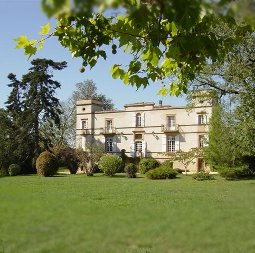|
Toulouse
The
perfect antidote to the numerous medieval villages of the area is a
trip south
to Toulouse. Within 40 minutes you can be in the centre of
this important
southern city. Built almost entirely of pink brick the city
has a unique
style and beauty, especially in the sunlight of a Mediterranean summers
day.
The
industrial life of the city revolves around the aerospace industry,
while a top
class university gives it a lively and youthful atmosphere.
Built on the
banks of the river Garonne, the old city is manageable on foot. The
main squares
are the Place du Capitol and the place Wilson, both offering great
places to sit
and watch the world go by. On the cultural trail St. Sernin
is an
excellent place to start. It is the most famous of the great
pilgrimage
churches of southern France. The present building was begun in the late
11th
century and completed in the 14th. The donation of relics by
Charlemagne
made it a centre for pilgrimmage and a stopping off place for the
Compostella
pilgrims. The musee St. Raymond houses the archaeological
museum.
Les Jacobins is the "mother church" of the Dominican order founded in
Toulouse in 1216. There are various museums tracing the
history of the
city and guided tours are organised by the tourist office which is
situated in
the old capitol building just behind the new one.
There
are also several
interesting markets in Toulouse, worth mentioning is the flea-market
around St.
Sernin on Sunday mornings. No description of the city is
complete without
the mention of woad, the blue dye that led many of the city merchants
to great
wealth and is responsible for the numerous fine private mansions, an
example of
which may be found in the Hotel d'Assezat. There are also
several splendid
chateaux to the north of Toulouse and one or two could be combined with
a day
trip to the city.
|
|
|
|
Aveyron
Gorges
From
your base you may head north east and follow the river Aveyron with its
steep
gorges along a most picturesque scenic route past the medieval towns of
Montricoux, Bruniquel (one of the most beautiful villages in France),
and Penne
with its historically important castle, before reaching the pretty town
of St.
Antonin-Noble-Val famed for its wealth of 13th - 15th century houses
built by
merchants who had grown rich on the cloth trade. The ancient
hotel de
ville built in 1125 is one of the oldest examples of civic architecture
in
France, together with the covered market it forms a wonderful backdrop
to the
main square where you can enjoy a relaxing drink outside the local bar
to
recover from the exertions of your sightseeing tour.
Beyond
St. Antonin there are a plethora of medieval towns and villages within
an easy
drive from Chateau des Peres.
Caylus has a covered market and
church that was once fortified. They hold regular pttery fairs and
other events.
Najac almost defies description as it
stands on a conical peak with the fortified castle towering above the
village,
it is breathtakingly beautiful, something from a fairy tale.
Turning south
through magnificent landscapes, you head towards the famous
Corde-sur-ciel.
The town was built in 1222, during the Albigensian crusade by the count
of
Toulouse, Raymond V11. Like St. Antonin, it prospered during
the 13th -
14th centuries because of the cloth trade. Today it is a great artistic
centre
and with its steep winding streets and medieval atmosphere it is not to
be
missed. From Cordes it is possible to complete the circuit
and return across country through Vaour and Penne, or you may continue
on to Albi. |
|
|
|
Albi
Your
drive to Albi, the city that gave its name to the crusade against the
Cathars,
will take you through the wonderful vineyards of the Gaillac
region. It is
among the oldest wine growing regions in France and produces a
consistently high
quality wine, which can be sampled by visiting one of the many
vineyards.
While in Gaillac itself visit the abbey church of St. Michel, founded
by the
Benedictines in the 7th century. Also at the Parc
de Foucard you
will find gardens laid out by Andre Le Notre, of Versailles
fame. Albi is
a most attractive town with lots to do and see.
The
old town is dominated by the fortress-like cathedral of Ste-Cecile,
built to
re-establish Catholic authority after the Albigensian
crusade. The Rood
screen and mural of The Last Judgement are a must! Next door to the
cathedral,
housed in the magnificent Palais De La Berbie, is the Musee
Toulouse-Lautrec
which has the most comprehensive collection of the artists
work. You
should also spend time just wandering around the old town, much of
which is
pedestrianised, enjoying the attractive shops (some good antiques) and
soaking
up the atmosphere of this red-brick city. From here it is
possible to head
south to Castres, with its Musee Goya and onto Mazamet and the Black
mountains.
You can return to base along the D999 or enjoy a cross country
adventure through
the forest of Sivens and Monclar-de-Quercy.
|
|
|
|
Moissac
Our
third itinery takes us west past Montauban and onto the town of Moissac
about 30
km away. The town lies among countryside covered with
orchards and
vineyards, it is most famous for its abbey church of St. Pierre and its
Romanesque cloisters. At its height the abbey was a stopover
point for
pilgrims on the route to St. James at Compostello, after passing
through Cahors
and Conques, both of which are within an easy distance to visit,
pilgrims would
rest here before taking the ferry across the junction of the Tarn and
Garonne
rivers.
Beyond
Moissac there are more pretty towns such as Lauzerte with its narrow
streets.
Once an important market centre, there are many historical
monuments.
Bourg-de-Visa is a picture postcard village with a covered market and
interesting church. Montaigu-de-Quercy is another medieval
town set among
beautiful countryside. Turning south it is possible to come
full circle
visiting Valence, St. Nicholas-de-la-Grave and Castelsarrasin.
|
|
 |


